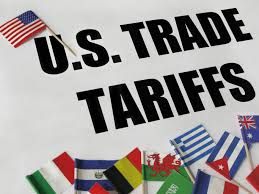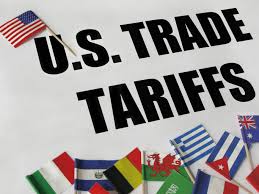
In a strategic maneuver intertwining trade policy with national security concerns, President Donald Trump has temporarily suspended the imposition of 25% tariffs on Mexico and Canada, contingent upon their commitments to enhance border security and combat crime. This development underscores the administration's approach of leveraging economic measures to achieve broader geopolitical objectives.
The decision to pause tariffs for 30 days follows agreements with Canadian Prime Minister Justin Trudeau and Mexican President Claudia Sheinbaum. Both leaders have pledged to bolster border enforcement in response to U.S. demands to curb illegal immigration and drug trafficking. Canada has committed to deploying advanced technology and additional personnel along its border with the United States, alongside initiating cooperative efforts to tackle organized crime, fentanyl smuggling, and money laundering. Mexico, on its part, has agreed to reinforce its northern border by deploying 10,000 National Guard members to stem the flow of illegal migration and narcotics. Additionally, the United States has pledged to prevent the trafficking of high-powered weapons into Mexico, addressing a longstanding concern of its southern neighbor.
This alignment of trade policy with border security highlights the use of economic leverage as a tool for diplomatic negotiation. By threatening substantial tariffs, the U.S. has secured tangible commitments from neighboring countries to address issues that have significant domestic implications. This approach reflects a broader geopolitical strategy where trade measures are employed not solely for economic objectives but as instruments to achieve national security goals.
The administration's tariff strategy appears to be driven by a combination of economic nationalism and foreign policy considerations. By imposing or threatening tariffs, the U.S. seeks to protect domestic industries from foreign competition, reduce trade deficits, and compel trading partners to address issues such as immigration control and drug trafficking. This multifaceted strategy underscores the administration's view of trade policy as a means to exert pressure on other nations to align with U.S. interests beyond the economic sphere.
The commitments from Canada and Mexico to enhance border security are poised to have significant economic implications. Strengthened border enforcement could lead to disruptions in the flow of goods and people across borders, potentially affecting trade and investment. Businesses that rely on cross-border supply chains may face increased costs and delays due to heightened security measures. Conversely, improved security could enhance the stability of the region, potentially fostering a more favorable environment for investment in the long term.
While agreements have been reached with Canada and Mexico, the situation with China remains contentious. The U.S. has proceeded with imposing a 10% tariff on Chinese imports, citing concerns over fentanyl trafficking among other issues. In response, China has announced retaliatory tariffs on U.S. exports, including coal, liquefied natural gas, and agricultural machinery, set to take effect on February 10. China has also initiated an investigation into Google for suspected antitrust violations, signaling a multifaceted response to U.S. actions. These developments indicate a deepening trade conflict between the two economic giants, with potential repercussions for global trade dynamics.
The issue of fentanyl trafficking has been a focal point in the U.S.-China trade dispute. President Trump has accused China of allowing the production of fentanyl, which is then smuggled into the United States, contributing to the opioid crisis. In response, the administration has utilized tariffs as a means to pressure China into taking more stringent measures to control the production and export of the synthetic opioid. China, however, has defended its narcotics policies and has challenged the U.S. tariffs at the World Trade Organization, while also expressing willingness to engage in negotiations.
The uncertainty surrounding trade policies has had immediate effects on financial markets. Following the announcement of the tariff pause with Canada and Mexico, the Canadian dollar experienced a significant appreciation after a prolonged decline. U.S. stock index futures also saw a positive shift after a period of losses, reflecting investor relief at the temporary de-escalation of trade tensions. However, the ongoing conflict with China continues to inject volatility into global markets, with potential implications for investment and economic growth.
The use of tariffs as a tool to achieve non-economic objectives represents a significant shift in U.S. trade policy. While this approach has yielded immediate concessions from neighboring countries, it also carries risks of economic disruption and strained diplomatic relations. The potential for retaliatory measures from affected countries could lead to a cycle of escalating trade barriers, adversely impacting global trade flows and economic stability. Moreover, the intertwining of trade policy with issues such as border security and crime control complicates international negotiations, as it broadens the scope of discussions beyond traditional economic parameters.
The current U.S. strategy of leveraging trade tariffs to achieve border security and crime control objectives reflects a complex interplay of economic and geopolitical considerations. While it has secured immediate commitments from Canada and Mexico, the broader implications of this approach warrant careful consideration. The potential for economic disruption, market volatility, and strained international relations underscores the need for a balanced strategy that addresses security concerns without undermining the foundational principles of free and fair trade.
(Source:www.reuters.com)
The decision to pause tariffs for 30 days follows agreements with Canadian Prime Minister Justin Trudeau and Mexican President Claudia Sheinbaum. Both leaders have pledged to bolster border enforcement in response to U.S. demands to curb illegal immigration and drug trafficking. Canada has committed to deploying advanced technology and additional personnel along its border with the United States, alongside initiating cooperative efforts to tackle organized crime, fentanyl smuggling, and money laundering. Mexico, on its part, has agreed to reinforce its northern border by deploying 10,000 National Guard members to stem the flow of illegal migration and narcotics. Additionally, the United States has pledged to prevent the trafficking of high-powered weapons into Mexico, addressing a longstanding concern of its southern neighbor.
This alignment of trade policy with border security highlights the use of economic leverage as a tool for diplomatic negotiation. By threatening substantial tariffs, the U.S. has secured tangible commitments from neighboring countries to address issues that have significant domestic implications. This approach reflects a broader geopolitical strategy where trade measures are employed not solely for economic objectives but as instruments to achieve national security goals.
The administration's tariff strategy appears to be driven by a combination of economic nationalism and foreign policy considerations. By imposing or threatening tariffs, the U.S. seeks to protect domestic industries from foreign competition, reduce trade deficits, and compel trading partners to address issues such as immigration control and drug trafficking. This multifaceted strategy underscores the administration's view of trade policy as a means to exert pressure on other nations to align with U.S. interests beyond the economic sphere.
The commitments from Canada and Mexico to enhance border security are poised to have significant economic implications. Strengthened border enforcement could lead to disruptions in the flow of goods and people across borders, potentially affecting trade and investment. Businesses that rely on cross-border supply chains may face increased costs and delays due to heightened security measures. Conversely, improved security could enhance the stability of the region, potentially fostering a more favorable environment for investment in the long term.
While agreements have been reached with Canada and Mexico, the situation with China remains contentious. The U.S. has proceeded with imposing a 10% tariff on Chinese imports, citing concerns over fentanyl trafficking among other issues. In response, China has announced retaliatory tariffs on U.S. exports, including coal, liquefied natural gas, and agricultural machinery, set to take effect on February 10. China has also initiated an investigation into Google for suspected antitrust violations, signaling a multifaceted response to U.S. actions. These developments indicate a deepening trade conflict between the two economic giants, with potential repercussions for global trade dynamics.
The issue of fentanyl trafficking has been a focal point in the U.S.-China trade dispute. President Trump has accused China of allowing the production of fentanyl, which is then smuggled into the United States, contributing to the opioid crisis. In response, the administration has utilized tariffs as a means to pressure China into taking more stringent measures to control the production and export of the synthetic opioid. China, however, has defended its narcotics policies and has challenged the U.S. tariffs at the World Trade Organization, while also expressing willingness to engage in negotiations.
The uncertainty surrounding trade policies has had immediate effects on financial markets. Following the announcement of the tariff pause with Canada and Mexico, the Canadian dollar experienced a significant appreciation after a prolonged decline. U.S. stock index futures also saw a positive shift after a period of losses, reflecting investor relief at the temporary de-escalation of trade tensions. However, the ongoing conflict with China continues to inject volatility into global markets, with potential implications for investment and economic growth.
The use of tariffs as a tool to achieve non-economic objectives represents a significant shift in U.S. trade policy. While this approach has yielded immediate concessions from neighboring countries, it also carries risks of economic disruption and strained diplomatic relations. The potential for retaliatory measures from affected countries could lead to a cycle of escalating trade barriers, adversely impacting global trade flows and economic stability. Moreover, the intertwining of trade policy with issues such as border security and crime control complicates international negotiations, as it broadens the scope of discussions beyond traditional economic parameters.
The current U.S. strategy of leveraging trade tariffs to achieve border security and crime control objectives reflects a complex interplay of economic and geopolitical considerations. While it has secured immediate commitments from Canada and Mexico, the broader implications of this approach warrant careful consideration. The potential for economic disruption, market volatility, and strained international relations underscores the need for a balanced strategy that addresses security concerns without undermining the foundational principles of free and fair trade.
(Source:www.reuters.com)





